skills acTion Plan for The food and Beverage secTor - Department of ...
skills acTion Plan for The food and Beverage secTor - Department of ...
skills acTion Plan for The food and Beverage secTor - Department of ...
Create successful ePaper yourself
Turn your PDF publications into a flip-book with our unique Google optimized e-Paper software.
CURRENT LABOUR MARKET AND<br />
EMPLOYMENT OUTCOMES<br />
high participation <strong>for</strong> some skill shortages<br />
low productivity<br />
variable sector <strong>and</strong> regional per<strong>for</strong>mance<br />
action by businesses<br />
<strong>and</strong> individuals<br />
major change projects<br />
aligning activities <strong>and</strong><br />
programmes<br />
A HIGH-PERFORMING LABOUR MARKET<br />
high participation <strong>for</strong> all who seek it<br />
globally-skilled work<strong>for</strong>ce<br />
high productivity<br />
high-per<strong>for</strong>ming sectors <strong>and</strong> regions<br />
Figure 1: Trans<strong>for</strong>mation <strong>The</strong>me. Source: Better Work, Working Better, <strong>Department</strong> <strong>of</strong> Labour.<br />
TRANSFORMATION THEME<br />
In order <strong>for</strong> the <strong>food</strong> <strong>and</strong> beverage sector to grow <strong>and</strong><br />
trans<strong>for</strong>m (towards a high skill, high wage, high value<br />
economy), a major shift will need to occur in several parts<br />
<strong>of</strong> the labour market (ie. increased productivity, including<br />
capacity to innovate through science <strong>and</strong> technology,<br />
reduced skill shortages <strong>and</strong> increased participation<br />
<strong>for</strong> those seeking to join the labour <strong>for</strong>ce but who are<br />
currently under-represented), as indicated in figure 1.<br />
<strong>The</strong> combination <strong>of</strong> these factors will change the way we<br />
manage <strong>and</strong> organise work in the future.<br />
<strong>The</strong> <strong>food</strong> service sector is the single largest employer<br />
in the <strong>food</strong> industry, followed closely by the <strong>food</strong> <strong>and</strong><br />
beverage manufacturing <strong>and</strong> <strong>food</strong> retail sectors.<br />
Of the approximately 337,020 people employed in <strong>food</strong><br />
<strong>and</strong> beverage, approximately 25% are involved in primary<br />
production, 20% in processing <strong>and</strong> manufacturing, 30%<br />
in wholesaling <strong>and</strong> retailing <strong>and</strong> 25% in the <strong>food</strong> service.<br />
Food <strong>and</strong> <strong>Beverage</strong> Employment by Sub-sector:<br />
A trans<strong>for</strong>mation will only be achieved through the ef<strong>for</strong>ts<br />
<strong>of</strong> industry <strong>and</strong> business organisations, unions <strong>and</strong> other<br />
organisations such as education <strong>and</strong> training providers.<br />
Government has a role in supporting <strong>and</strong> facilitating<br />
change at the individual business, regional, sector <strong>and</strong><br />
national levels.<br />
Key Facts about the Food <strong>and</strong><br />
<strong>Beverage</strong> Sector<br />
<strong>The</strong> <strong>food</strong> <strong>and</strong> beverage sector is a major contributor to<br />
the New Zeal<strong>and</strong> economy. In terms <strong>of</strong> export earnings,<br />
the sector recorded $15.4 billion in 2004 compared to $9.3<br />
billion in 1994, representing an annual compound growth<br />
rate <strong>of</strong> 5.2% during this period.<br />
In 2005, approximately, one in ten people worked in the<br />
sector <strong>and</strong> it employed 20% <strong>of</strong> the working population.<br />
16



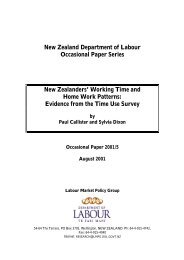

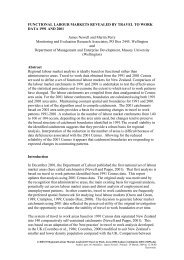
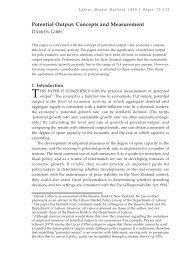

![a note on levels, trends, and some implications [pdf 21 pages, 139KB]](https://img.yumpu.com/27285836/1/184x260/a-note-on-levels-trends-and-some-implications-pdf-21-pages-139kb.jpg?quality=85)


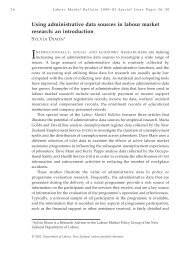


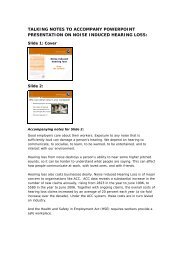
![Labour Market Trends and Outlook - 1996 [pdf 18 pages, 94KB]](https://img.yumpu.com/27285764/1/184x260/labour-market-trends-and-outlook-1996-pdf-18-pages-94kb.jpg?quality=85)

